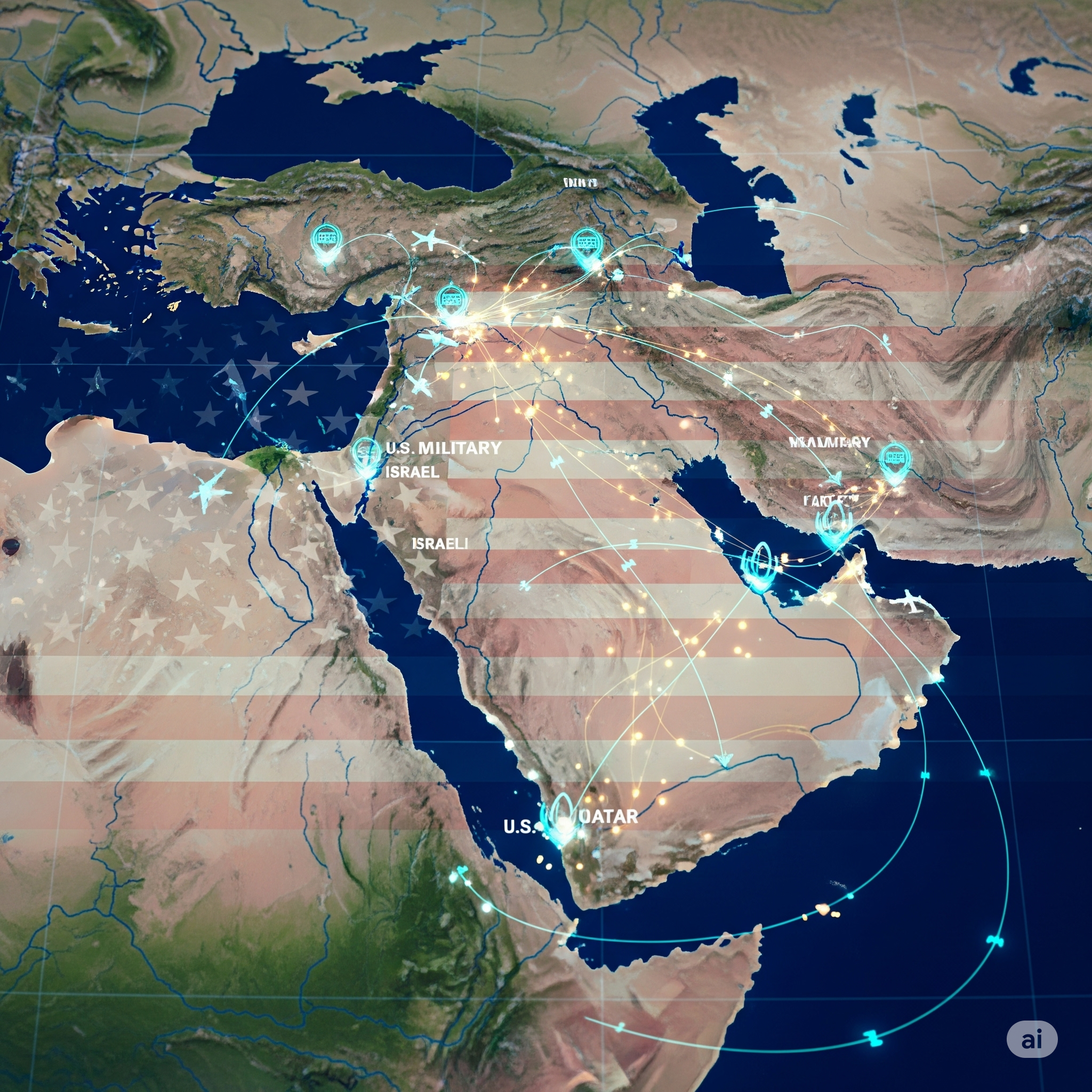The Illusion of Disengagement
For years, successive U.S. administrations—from Obama to Biden and beyond—have promised to “pivot away” from the Middle East. The logic was sound: focus on Asia, contain China, and reduce costly entanglements in a region often called a “graveyard of empires.”
Yet in 2025, the U.S. is still firmly embedded in Middle Eastern affairs—militarily, diplomatically, and economically. Why can’t the U.S. walk away? The answer lies in a complex web of interests that go far beyond oil.
⚙️ Strategic Realities: Why Disengagement Isn’t an Option
1. 🛢️ Energy Security Is Changing—But Not Disappearing
While the U.S. has become energy independent in crude oil, global oil markets are still interconnected. The Middle East, particularly the Persian Gulf, remains:
- Home to 30% of global oil reserves
- Central to shipping lanes like the Strait of Hormuz, through which 20% of the world’s oil flows
- A critical swing producer that influences global prices
In 2022–2024, energy price shocks from conflicts involving Iran, Yemen (via the Houthis), and the Israel-Gaza war demonstrated that U.S. domestic energy security is still vulnerable to Middle East disruptions.
💡 Insight: The energy transition is real, but fossil fuel geopolitics still matters—especially for allies like Japan, South Korea, and Europe, which depend heavily on Middle Eastern oil and LNG.
2. 🤝 Old Alliances, New Pressures
🟦 Israel
- U.S. remains Israel’s top defense partner, providing $3.8B annually in military aid.
- The 2023–2024 escalation involving Hezbollah and Gaza further solidified the alliance.
- Technological and intelligence-sharing partnerships (AI surveillance, Iron Dome upgrades) are at an all-time high.
🟨 Saudi Arabia
- Tense but crucial. U.S. interests in:
- Counterterrorism cooperation
- Stabilizing OPEC+ dynamics
- Monitoring Iranian activities
- Riyadh’s pivot toward China and BRICS in 2024 raised alarms in Washington.
🟥 Gulf States (UAE, Qatar, Bahrain)
- Key locations for CENTCOM operations
- Partners in energy investments, counterterrorism, and space programs
🔍 Even as these nations assert more independence, the U.S. provides the defense umbrella they still depend on—especially amid rising regional threats.
3. 🧨 Iran: Containment Without Confrontation
Iran remains one of the most significant reasons for U.S. entrenchment in the region.
Current 2025 Context:
- JCPOA revival has collapsed
- Iran’s nuclear enrichment reached 60% U-235, raising fears of a breakout capability
- Proxy networks in Iraq, Syria, Lebanon, and Yemen remain active
- Cyberattacks allegedly originating from Iran have targeted U.S. infrastructure and Israeli partners
Why the U.S. Stays:
- To monitor and disrupt Iran’s regional ambitions
- To protect allies like Israel, Jordan, and Iraq
- To keep the Hormuz Strait open and secure global supply chains
🎯 Complete disengagement would create a vacuum, one Iran could fill—at the cost of regional and global stability.
4. 🛰️ Military Basing and Force Projection
Even as troops are withdrawn, U.S. military assets remain deeply entrenched:
| Base | Country | Purpose |
|---|---|---|
| Al Udeid | Qatar | Largest U.S. airbase in the region |
| Al Dhafra | UAE | Drone surveillance, quick strike capability |
| Camp Arifjan | Kuwait | Ground logistics, rapid deployment |
| Red Sea Naval Ops | Bahrain | Maritime security, anti-piracy |
In a world where great power competition is rising, maintaining force projection capabilities from the Middle East allows the U.S. to:
- Contain Russia’s influence in Syria
- Monitor China’s growing ties with Iran and Gulf states
- Secure Red Sea and Suez Canal trade routes
5. 💣 Terrorism Isn’t Gone—It’s Evolved
While ISIS’s territorial control has diminished, terrorist networks are adapting:
- Al-Qaeda in the Arabian Peninsula (AQAP) remains active in Yemen
- ISIS-K poses threats in Afghanistan and potentially in Iran’s eastern border
- Lone-wolf radicalization and cyberterrorism are on the rise
The U.S. counterterrorism infrastructure, from drones to intelligence partnerships, cannot be easily outsourced or eliminated.
📌 The Middle East remains a launchpad for extremist ideologies, many of which threaten Western interests globally.
🔄 The China & Russia Factor: Geostrategic Competition
The U.S. cannot leave the Middle East without ceding influence to rival powers:
🇷🇺 Russia
- Maintains military bases in Syria
- Acts as a spoiler in UN diplomacy, arms transfers to Iran and Libya
🇨🇳 China
- Signed a 25-year strategic deal with Iran
- Is the largest oil importer from Saudi Arabia, Iraq, and Iran
- Expanding its digital and security footprint, including Huawei-led infrastructure projects
🧠 Geo-economic competition is becoming as important as traditional military concerns.
🗳️ Domestic Politics vs Strategic Necessity
While American public opinion often favors disengagement, especially after Iraq and Afghanistan, policymakers face a dilemma:
- The political cost of staying is high—but…
- The strategic cost of leaving could be catastrophic.
Thus, the U.S. adopts a “light footprint” model:
- More drones, fewer boots
- More contractors, less media coverage
- More tech and intelligence ops, fewer direct interventions
🎯 It’s not a withdrawal—it’s a rebranding of U.S. presence.
🔮 What the Future Holds: Realignment, Not Exit
2025–2030 Outlook:
- More reliance on regional partners (UAE, Jordan, Saudi, Israel) to manage security
- Increased focus on tech diplomacy—AI governance, 5G infrastructure, digital surveillance
- Cyberwarfare and drone countermeasures will define future conflict
Expect fewer large-scale invasions, but more:
- Covert ops
- Cyber skirmishes
- AI-driven intelligence campaigns
🧠 Conclusion: Leaving the Middle East Is a Myth
The U.S. might not want to be in the Middle East, but it can’t afford to leave.
With overlapping threats from Iran, resurgent terrorism, energy geopolitics, and great power rivalry, the region remains a strategic chokepoint—not just for the U.S., but for the entire global order.
Walking away would not create peace—it would invite instability.









+ There are no comments
Add yours